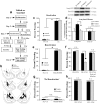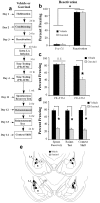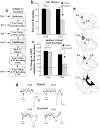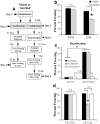A naturally-occurring histone acetyltransferase inhibitor derived from Garcinia indica impairs newly acquired and reactivated fear memories
- PMID: 23349897
- PMCID: PMC3549978
- DOI: 10.1371/journal.pone.0054463
A naturally-occurring histone acetyltransferase inhibitor derived from Garcinia indica impairs newly acquired and reactivated fear memories
Erratum in
-
Correction: A Naturally-Occurring Histone Acetyltransferase Inhibitor Derived from Garcinia indica Impairs Newly Acquired and Reactivated Fear Memories.PLoS One. 2017 Jul 17;12(7):e0181892. doi: 10.1371/journal.pone.0181892. eCollection 2017. PLoS One. 2017. PMID: 28715509 Free PMC article.
Abstract
The study of the cellular and molecular mechanisms underlying the consolidation and reconsolidation of traumatic fear memories has progressed rapidly in recent years, yet few compounds have emerged that are readily useful in a clinical setting for the treatment of anxiety disorders such as post-traumatic stress disorder (PTSD). Here, we use a combination of biochemical, behavioral, and neurophysiological methods to systematically investigate the ability of garcinol, a naturally-occurring histone acetyltransferase (HAT) inhibitor derived from the rind of the fruit of the Kokum tree (Garcina indica), to disrupt the consolidation and reconsolidation of Pavlovian fear conditioning, a widely studied rodent model of PTSD. We show that local infusion of garcinol into the rat lateral amygdala (LA) impairs the training and retrieval-related acetylation of histone H3 in the LA. Further, we show that either intra-LA or systemic administration of garcinol within a narrow window after either fear conditioning or fear memory retrieval significantly impairs the consolidation and reconsolidation of a Pavlovian fear memory and associated neural plasticity in the LA. Our findings suggest that a naturally-occurring compound derived from the diet that regulates chromatin function may be useful in the treatment of newly acquired or recently reactivated traumatic memories.
Conflict of interest statement
Figures








Similar articles
-
p300/CBP histone acetyltransferase activity is required for newly acquired and reactivated fear memories in the lateral amygdala.Learn Mem. 2013 Jan 17;20(2):109-19. doi: 10.1101/lm.029157.112. Learn Mem. 2013. PMID: 23328899 Free PMC article.
-
A diet enriched with curcumin impairs newly acquired and reactivated fear memories.Neuropsychopharmacology. 2015 Mar 13;40(5):1278-88. doi: 10.1038/npp.2014.315. Neuropsychopharmacology. 2015. PMID: 25430781 Free PMC article.
-
Epigenetic alterations in the lateral amygdala are required for reconsolidation of a Pavlovian fear memory.Learn Mem. 2011 Aug 25;18(9):579-93. doi: 10.1101/lm.2243411. Print 2011 Sep. Learn Mem. 2011. PMID: 21868438 Free PMC article.
-
The role of endocannabinoids in consolidation, retrieval, reconsolidation, and extinction of fear memory.Pharmacol Rep. 2021 Aug;73(4):984-1003. doi: 10.1007/s43440-021-00246-y. Epub 2021 May 6. Pharmacol Rep. 2021. PMID: 33954935 Review.
-
Transcriptional Regulation Involved in Fear Memory Reconsolidation.J Mol Neurosci. 2018 Jun;65(2):127-140. doi: 10.1007/s12031-018-1084-4. Epub 2018 May 23. J Mol Neurosci. 2018. PMID: 29796837 Review.
Cited by
-
Mechanisms governing the reactivation-dependent destabilization of memories and their role in extinction.Front Behav Neurosci. 2013 Dec 26;7:214. doi: 10.3389/fnbeh.2013.00214. Front Behav Neurosci. 2013. PMID: 24421762 Free PMC article. Review.
-
Vitamin A deficiency impairs spatial learning and memory: the mechanism of abnormal CBP-dependent histone acetylation regulated by retinoic acid receptor alpha.Mol Neurobiol. 2015 Apr;51(2):633-47. doi: 10.1007/s12035-014-8741-6. Epub 2014 May 24. Mol Neurobiol. 2015. PMID: 24859384
-
Context and Auditory Fear are Differentially Regulated by HDAC3 Activity in the Lateral and Basal Subnuclei of the Amygdala.Neuropsychopharmacology. 2017 May;42(6):1284-1294. doi: 10.1038/npp.2016.274. Epub 2016 Dec 7. Neuropsychopharmacology. 2017. PMID: 27924874 Free PMC article.
-
The potential of epigenetics in stress-enhanced fear learning models of PTSD.Learn Mem. 2016 Sep 15;23(10):576-86. doi: 10.1101/lm.040485.115. Print 2016 Oct. Learn Mem. 2016. PMID: 27634148 Free PMC article. Review.
-
Exploring epigenetic regulation of fear memory and biomarkers associated with post-traumatic stress disorder.Front Psychiatry. 2013 Jul 1;4:62. doi: 10.3389/fpsyt.2013.00062. eCollection 2013. Front Psychiatry. 2013. PMID: 23847551 Free PMC article.
References
-
- Milner B, Squire LR, Kandel ER (1998) Cognitive neuroscience and the study of memory. Neuron 20: 445–468. - PubMed
-
- Sara SJ (2000) Retrieval and reconsolidation: toward a neurobiology of remembering. Learn Mem 7: 73–84. - PubMed
-
- Nader K (2003) Memory traces unbound. Trends Neurosci 26: 65–72. - PubMed
-
- Pitman RK, Shalev AY, Orr SP (2000) Posttraumatic stress disorder: emotion, conditioning, & memory. In: Gazzaniga MS, editor. The New Cognitive Neurosciences. Cambridge: MIT Press.
-
- Tronson NC, Taylor JR (2007) Molecular mechanisms of memory reconsolidation. Nat Rev Neurosci 8: 262–275. - PubMed
Publication types
MeSH terms
Substances
Grants and funding
LinkOut - more resources
Full Text Sources
Other Literature Sources
Medical

